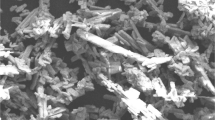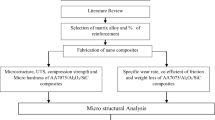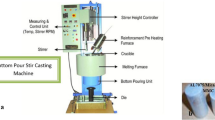Abstract
Composite materials are the recent advancement technique in the field of material science. A composite material gives a unique property that is never shown from the particular alloy material. The dispersion of Reinforcement particles with the matrix material changes its mechanical and tribological properties. Because of its lightweight and high strength, Aluminum Metal Matrix Composite AMMC is used in many fields. Depends upon the Reinforcement particles, matrix property can change. Aluminum 7075 is the durable alloy used in the aerospace and automotive industries. In this present investigation, Al 7075 is dispersed with Alumina (Al2O3) and Mica by the stir casting process. And the samples are characterized by various mechanical tests like Hardness test and Impact test and studied using a scanning electron microscope. From the report, the mechanical properties of Al 70775 compositions are improved compared to the non-reinforced base material.
Similar content being viewed by others
Explore related subjects
Discover the latest articles, news and stories from top researchers in related subjects.Avoid common mistakes on your manuscript.
1 Introduction
The modern engineering world expects a material with high strength and low weight. In the past few years, metal matrix composite materials, polymers, and ceramics have played a vital role in mechanical industries. They are high in strength and low in weight, and Composite density materials have risen in quantity and product numbers continually, entering and consistently capturing new markets. Most of the engineered materials market, ranging from everyday products to sophisticated niche applications, contains modern composite materials. Compared to their traditional material, the composite materials are lightweight and are proved. Kumar et al. [1] reported that Al2O3 and SiC resulted in improving the hardness and density of the aluminum composite. Also, they said 2–6% of Al2O3 fabricated by liquid metallurgy technique would improve the hardness of the composite material. Kumar et al. [1]. The composite of Al7075 with Al2O3has excellent hardness and tensile properties than Al6061 with SiC. The wear rate of the composite materials is decreasing while increasing the distance of sliding and minimum speed. Baradeswaran et al. [2] A have investigated that Al2O3can improve the tensile, hardness, and flexural strength. The presence of Graphite was used to reduce the coefficient of friction. He prepared an Aluminium composite of 5% graphite with 2–8% of Al2O3 by Liquid metallurgy technique was show good mechanical results end wear resistance properties. The addition of Graphite may reduce the hardness of the composite material.
Raghavendra et al. [3] have investigated the tribological characterization of Al7075 with Al2O3 and SiC. Reinforcement particle of Alumina taken in the form of 50–150 micron. They prepared a ratio of 3% SiC and 3–12% Alumina by Stir Casting technique. Finally, he reports that Al7075, with 3% of both SiC and Alumina, has better tribological properties. Sambathkumar et al. [4] reported that the mechanical properties of the hardness of Aluminium 7075 with Alumina by stir casting technique. From the testing, they report that 15% of Alumina of 36-micron particle size exhibits the highest microhardness in VHN. Up to 135 VHN was obtained from the 36-micron particle size with 360 °C. Imran et al. [5] have reported the mechanical properties of Al7075 with alumina metal matrix composite by Stir casting technique. It is found that 8% of Alumina with Al7075 has the highest mechanical properties. This ratio has the highest value in the Brinell hardness test, Impact test, and Ultimate load test. Some of the innovative and efficient manufacturing techniques are successfully implemented in many manufacturing industries to produce composite materials. This research work useful for manufacturing cost-effective composite parts for many revolutionary development methods in the mechanical industry. Increasing manufacturing technology is evident, especially for composites, not only to overcome the cost barrier. In architecture, materials, processes, equipment, quality control, manufacturing, and even program management for composites to compete with metals, an integrated effort must be made (Table 1).
2 Experimental Methodology
2.1 Fabrication of Composite Material
Aluminum Metal Matrix Composites (AMMCs), their advanced properties, such as higher strength, improved rigidity, reduced density, enhanced high-temperature characteristics, regulated temperature thresholds, enhanced and tailored electrical characteristics, better abrasion and wear resistance, weight control, and better damping capability, make these AMMCs more demanding [6].
The most flexible materials for advanced structural, automobile, aerospace, aviation, maritime, defense, and other related fields are emerging due to their excellent combination of properties [7]. Aluminum metal matrix composites are the highest components. The study Al7075, mixed with Al2O3, MICA to composite preparation through stir casting method. The various Weight Percentage (wt%) reinforcement from Al7075/ 3% of Al2O3/ 10–30% Mica for total weight 1 kg shown in Table 3. The Al7075 has contained various materials composition shown in Table 2.
A dry sliding wear test using a pin-on-disk wear tester was used to study the Al7075 alloy shown in Fig. 1, composites, and their wear and frictional properties of composites. For various loads, speeds, and sliding distances, the sliding wear tests were performed. The result shows that the wear rates of the composite are lower than that of the composite matrix. The adding of both ceramic powder with different particles in Al7075 alloy enhances the tribological characteristics [8].
The composite's deformation and fracture behavior showed the importance of particle grain size. The proportional limit, yield stress, and the extreme stress of tensile strength are reduced by reducing the particle size. For this purpose here, we choose the Al2O3 and Mica for preparing the metal matrix composite shown in Figs. 2 and 3.
Because of the tendency to fracture, big particles have shown to be harmful to their fracture. A composite system where the reinforcement component is relatively small (4 μm or less), is highly desirable, to achieve the rigidity advantages of a composite without reducing fracture toughness significantly. Gangadhar et al. [9] the Al7075 was heated in a furnace with a temperature of 950 °C, heated up to 45 min for complete melting. Then Al2O3 and Mica powder added with molten metal till complete melting, which is assisting with stir route for proper mixing.
2.2 Pin on Disc Friction &Wear Tester
A standard cylindrical pin is made of 8 mm diameter and 25 mm long. The disk was 180 mm in diameter and 12 mm thick. The disk is ground to have a 0.8-µm surface resistance shown in Fig. 4. The disk is made of EN-25 highly polished steel with a hardness of approximately 60 RHN. The wear test results measure the height loss of the pinned specimen in microns. The pin wear loss measurement was used in the wear test to assess wear loss.
2.3 Hardness Test
The hardness is defined by means of abrasion, boiling, impact, scraping or rubbing determined by a hardness test like Brinell, Vickers, as a resistance of the material against deformation or penetration [10]. Hardness is a function of how durable solid matter shifts in different forms of permanent form when applying compressive force. The hardness machines from Brinell and Rockwell are best suited to the hardness of the material presented in Fig. 5.
2.4 Impact Test
Impact strength is the ability to withstand the load while suddenly applied, and it denoted at the energy. It frequently measured with Izod impact strength or a Charpy impact test, both measuring the impact energy necessary for fracturing a sample (Fig. 6).
3 Results and Discussion
3.1 Wear Rate Observation
The composite wear investigation is carried out by the pin on the disc. All prepared samples wear rate calculated with the 400 rpm of disk speed and constant load 40 N. This investigation used to predict the frictional force and wear rate of the composite samples. Based on the results in Table 3, sample 3 has a low wear rate, and the frictional force compares to others.
The results confirmed that sample 3 of Al 7075 + 3% Al2O3 + 3% Mica has a low wear rate than the other samples. From the results, we confirm that sample 3 has a low friction force than the other two samples. The dispersion of mica powder in the aluminum matrix improves the wear resistance of the matrix material [11]. Figures 7, 8 and 9 represent the wear rate that occurs from samples 1,2, and 3 at the duration of 0–100 s.
Coefficient of friction calculated from the friction force and applied normal force. Here the three samples under investigation to find out the coefficient of friction to the different composites. Based on the result, while increasing the Al2O3 and mica particles, it reduces the coefficient of friction rate. The results of the coefficient for three samples shown in Figs. 10, 11, and 12.
Figures 13, 14, and 15 represent the frictional force of the different composite materials. Based on the results, the coefficient of friction depends on the frictional force. If the Al2O3 and Mica percentage increased, it leads to reduce frictional force value and also the coefficient friction.
3.2 Hardness and Impact Result
From the report, the Hardness of Aluminum alloy increase with an increase in Mica reinforcement particles. Dispersion of Mica reinforcement with Al2O3 in Al7075 increases its hardness property. Aluminum 7075 with 3% Al2O3 and 3% Mica has a high hardness value than the other two samples. The impact strength of Aluminum 7075 alloy does not have any significant changes (Table 4).
3.3 Scanning Electron Microscope Analysis
The microstructure image used to find distribution of particles on the surface and the bonding between the materials [12]. Figures 16, 17, and 18 can obtain the microstructural behavior of different composite materials. Sample 16 shows the excellent roughness profile. Figure 17 and 18 surface profile more roughness compare with Fig. 16, due to adding the Al2O3 and Mica particles.
4 Conclusion
Wear of the Aluminium alloy with Reinforcements were investigated on the pin on disc tribometer conforms to the specification of ASTM by the defined specific loads, specified speed of the disc, and the sliding distance. The conclusions based on the present work of Aluminium 7075 alloy with Al2O3 and Mica metal matrix composites are as follows.
-
1.
Aluminum 7075 alloys with Al2O3 and Mica composites are successfully prepared using the stir casting method.
-
2.
The higher value of wear resistance is observed in 3% Mica reinforcement particles with constant Al2O3.
-
3.
So wear rate of Al 7075 composition decrease with an increase in Mica powder when the Al2O3 is kept constant.
-
4.
Also, the hardness is high for 3% Mica particles with a constant 3% Al2O3.
-
5.
So the presence of Mica powder increases the hardness of Aluminum 7075 alloy when the Al2O3 is kept constant.
-
6.
The impact strength of different ratios of Aluminum alloy does not change as much. So it depends upon the Al2O3. Due to the constant amount of Al2O3, the impact strength does not vary as much.
References
G.V. Kumar, C.S.P. Rao, N. Selvaraj, M.S. Bhagyashekar, Studies on Al6061-SiC and Al7075-Al2O3 metal matrix composites. J. Miner. Mater. Charact. Eng. 9(1), 43–55 (2010)
A. Baradeswaran, A.E. Perumal, Study on mechanical and wear properties of Al 7075/Al2O3/graphite hybrid composites. Compos. B Eng. 56, 464–471 (2014)
N. Raghavendra, V.S. Ramamurthy, Tribological characterization of AL7075/AL203/SIC reinforced hybrid particulate metal matrix composite developed by stir casting process. Int. J. Recent Adv. Mech. Eng. (IJMECH) 4, 113 (2015)
M. Sambathkumar, P. Navaneethakrishnan, K.S.K.S. Ponappa, K.S.K. Sasikumar, Mechanical and corrosion behavior of Al7075 (hybrid) metal matrix composites by two step stir casting process. Latin Am. J. Solids Struct. 14(2), 243–255 (2017)
M. Imran, A.A. Khan, Characterization of Al-7075 metal matrix composites: a review. J. Mater. Res. Technol. 8(3), 3347–3356 (2019)
S. Suresh, G.H. Gowd, M.D. Kumar, Mechanical properties of AA 7075/Al 2 O 3/SiCnano-metal matrix composites by stir-casting method. J. Inst. Eng. Ser. D 100(1), 43–53 (2019)
B.R. Krishnan, M. Ramesh, Experimental evaluation of Al-Zn-Al2O3 composite on piston analysis by CAE tools. Mech. Mech. Eng. 23(1), 212–217 (2019)
P. Saravanan, M.S. Priyan, R. Raghuram, S.S. Kumar, T. Anand, Investigation of mechanical properties in aluminium silicon carbide mica hybrid metal matrix composite. Int. J. Eng. Sci. Adv. Technol. 5, 112–117 (2015)
T.G. Gangadhar, D.P. Girish, A.P. Chandra, G. Angadi, K.K. Raj, Study on tensile and hardness properties of aluminium 7075 alloy reinforced with graphite, mica and e-glass. Intelligent manufacturing and energy sustinability (Springer, Singapore, 2020), pp. 533–541
J. Leng, Q. Zhou, Q. Zhao, G. Wu, Properties of Hybrid-Reinforced aluminum matrix composites for precision instruments. J. Inorg. Organomet. Polym. Mater. 22(1), 253–257 (2012)
N.S. Kumar, Fabrication and characterization of Al7075/RHA/Mica composite by squeeze casting. Mater. Today Proc. (2020). https://doi.org/10.1016/j.matpr.2020.05.769
J. Mu, Y. Zhou, X. Bu, T. Zhang, Preparation and Characterization of micron-sized PMMA/SiO 2 composite microspheres. J. Inorg. Organomet. Polym. Mater. 24(4), 776–779 (2014)
Author information
Authors and Affiliations
Corresponding author
Additional information
Publisher's Note
Springer Nature remains neutral with regard to jurisdictional claims in published maps and institutional affiliations.
Rights and permissions
About this article
Cite this article
kishore, G., Parthiban, A., Krishnan, A.M. et al. Experimental Investigation of Mechanical and Wear Properties of AL7075/Al2O3/MICA Hybrid Composite. J Inorg Organomet Polym 31, 1026–1034 (2021). https://doi.org/10.1007/s10904-020-01749-6
Received:
Accepted:
Published:
Issue Date:
DOI: https://doi.org/10.1007/s10904-020-01749-6






















